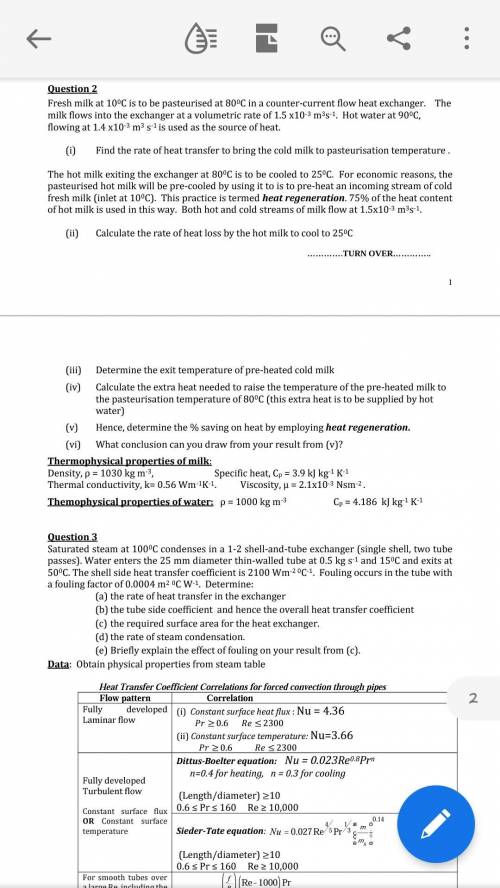
Engineering, 10.06.2020 01:57 deidrabenson72331
Fresh milk at 100C is to be pasteurised at 800C in a counter-current flow heat exchanger. The milk flows into the exchanger at a volumetric rate of 1.5 x10-3 m3s-1. Hot water at 900C, flowing at 1.4 x10-3 m3 s-1 is used as the source of heat. (i) Find the rate of heat transfer to bring the cold milk to pasteurisation temperature . The hot milk exiting the exchanger at 800C is to be cooled to 250C. For economic reasons, the pasteurised hot milk will be pre-cooled by using it to is to pre-heat an incoming stream of cold fresh milk (inlet at 100C). This practice is termed heat regeneration. 75% of the heat content of hot milk is used in this way. Both hot and cold streams of milk flow at 1.5x10-3 m3s-1. (ii) Calculate the rate of heat loss by the hot milk to cool to 250C (iii) Determine the exit temperature of pre-heated cold milk (iv) Calculate the extra heat needed to raise the temperature of the pre-heated milk to the pasteurisation temperature of 800C (this extra heat is to be supplied by hot water) (v) Hence, determine the % saving on heat by employing heat regeneration. (vi) What conclusion can you draw from your result from (v)?


Answers: 3


Another question on Engineering

Engineering, 03.07.2019 14:10
Amass of 1.5 kg of air at 120 kpa and 24°c is contained in a gas-tight, frictionless piston-cylinder device. the air is now compressed to a final pressure of 720 kpa. during the process, heat is transferred from the air such that the temperature inside the cylinder remains constant. calculate the boundary work input during this process.
Answers: 2

Engineering, 03.07.2019 15:10
Apiston-cylinder with a volume of 0.25 m3 holds 1 kg of air (r 0.287 k/kgk) at a temperature of 100 c. heat transfer to the cylinder causes an isothermal expansion of the piston until the volume triples. how much heat is added to the piston-cylinder?
Answers: 3

Engineering, 04.07.2019 18:10
Water at the rate of 1 kg/s is forced through a tube with a 2.5 cm inner diameter. the inlet water temperature is 15°c, and the outlet water temperature is 50°c. the tube wall temperature is 14°c higher than the local water temperature all along the length of the tube. what is the length of the tube?
Answers: 3

Engineering, 04.07.2019 18:20
Water vapor initially at 10 bar and 400 °c is contained within a piston-cylinder assembly. the water lost heat to the surrounding according to isochoric (iso-volumetric) process until its temperature is 150 °c. the water is then condensed isothermally to saturated liquid. for the water as a system, calculate the work in kj/kg
Answers: 2
You know the right answer?
Fresh milk at 100C is to be pasteurised at 800C in a counter-current flow heat exchanger. The milk f...
Questions

Mathematics, 27.01.2021 17:30

Mathematics, 27.01.2021 17:30

Mathematics, 27.01.2021 17:30

History, 27.01.2021 17:30




Mathematics, 27.01.2021 17:30

History, 27.01.2021 17:30

Mathematics, 27.01.2021 17:30

Health, 27.01.2021 17:30

English, 27.01.2021 17:30


Social Studies, 27.01.2021 17:30

Arts, 27.01.2021 17:30


English, 27.01.2021 17:30

Biology, 27.01.2021 17:30

Mathematics, 27.01.2021 17:30




